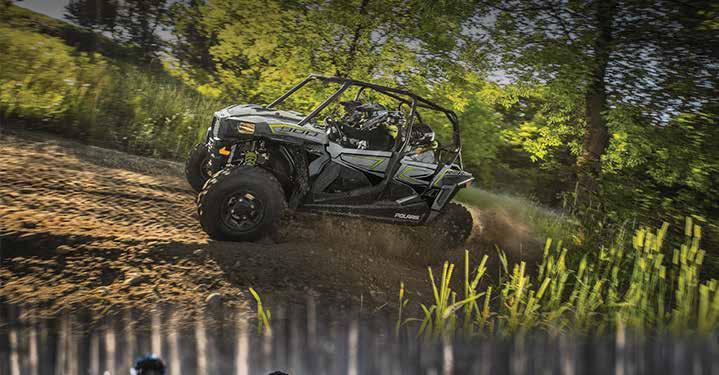Spring is for the birds...
RETURN PLUS: ALL ABOUT BIRD BOXES


WINNING THE LOTTERY
THE MAINE MOOSE PERMIT LOTTERY RETURNS TO FORT KENT GET OUT ON THE WATER FISHING, KAYAKING, WHITEWATER RAFTING & MORE


Spring is for the birds...
RETURN PLUS: ALL ABOUT BIRD BOXES


WINNING THE LOTTERY
THE MAINE MOOSE PERMIT LOTTERY RETURNS TO FORT KENT GET OUT ON THE WATER FISHING, KAYAKING, WHITEWATER RAFTING & MORE

Of the many anticipated signs of spring in Maine, the return of ospreys is among the most easily observed. Flying up from their wintering grounds in the south, these fish-eating raptors build large, conspicuous stick nests atop trees, telephone poles, dock pilings, and other tall structures.
Apparently they don’t mind standing out, and they’re fun to watch.
“Their hunting skills are really impressive,” said Erynn Call, raptor biologist for the Maine Department of Inland Fisheries and Wildlife.
Hovering high over the water, ospreys will spot a fish, dive feet first, plunge into the water, and grab it.
“They can see something below the surface of the water even if they’re 100 feet up,” said Chris DeSorbo, director of Biodiversity Research Institute's raptor program. “It’s like binocular vision.”
Unlike Maine’s other hawk species, they’ll submerge to grab a fish. But water doesn’t slow them down much. Resurfacing, they immediately take flight, shaking the water from their feathers as they rise.
Their accuracy is startling. Studies have recorded ospreys catching fish at least one in every four dives, with success rates sometimes as high as 70 percent, according to the Cornell Lab of Ornithology.
(Above)
(Right)

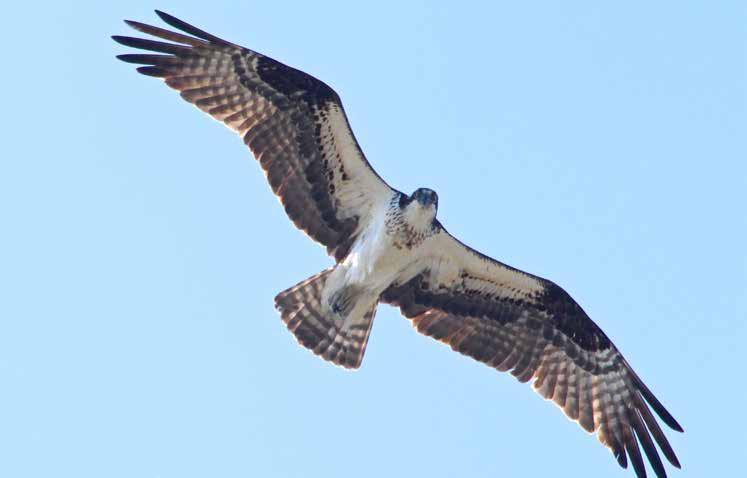
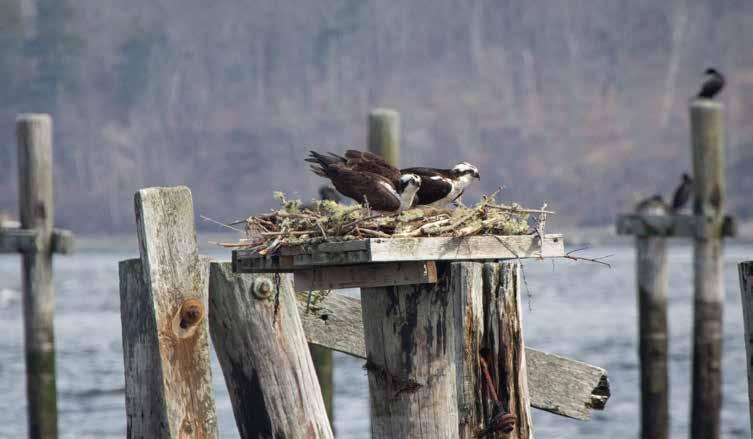

The average time ospreys spend hunting before making a catch? Just 12 minutes.
They’re a bird that’s built to fish — right down to their feet. Unusual among hawks, they possess a reversible outer toe that allows them to grab a fish with two toes in front and two behind. Barbed pads on the soles of their feet also help them secure their quarry.
“You’ll see that their feet have this amazing scaly, sandpaper texture, which is pretty helpful when trying to hold onto a slippery fish,” DeSorbo said.
Today, the osprey is a common sight in Maine, but they weren’t always so numerous. Back in the 1950s and 60s, bird populations throughout the United States plummeted due to the use of pesticides such as DDT, which caused eggshells to thin and break.
“Ospreys were one of the species that helped people figure out that DDT was having the devastating effect on birds that it was,” DeSorbo said, explaining
that because the bird nests in such visible locations, it’s easy for scientists to monitor them.
If observing a pair of nesting ospreys this spring, keep an eye out for one to three chicks. Both adults will feed them, carrying fish back to the nest — with the fish always oriented head first to reduce wind resistance.
Since the ban of DDT in 1972, ospreys and other birds, including bald eagles, have rebounded. Today, Maine’s osprey population appears to be stable based on surveys conducted in Casco Bay, said DeSorbo and Call.
Pairs return to the same nesting sites year after year, and their young tend to nest nearby. Males collect most of the nesting material, while females arrange it. Over time, a nest can grow to be over 10 feet deep and 6 feet in diameter — big enough for a person to sit in — according to the Cornell Lab of Ornithology.
The osprey is tied to other birds in interesting and unexpected ways. For example,
smaller birds, such as common grackles, sometimes nest in the lower parts of active osprey nests, according to Mary Holland in the book “Naturally Curious.”
In Maine specifically, ospreys have been observed nesting within heron colonies, Call said, and peregrine falcons sometimes use old osprey nests. But perhaps the osprey’s greatest tie to another species is to the bald eagle — which basically serves as its archenemy. Bald eagles are often witnessed stealing ospreys’ fish by harassing them in the sky.
“They’ll basically pester them until they’re too tired to continue on, and then they’ll drop the fish,” DeSorbo said. “Often eagles will catch it from the air before it even hits the water.”
If observing a pair of nesting ospreys this spring, keep an eye out for one to three chicks. Both adults will feed them, carrying fish back to the nest — with the fish always oriented head first to reduce wind resistance.
It takes about two months for baby ospreys to fledge, but they continue to call the nest home until they migrate south in the fall. Then they’ll travel as far as central South America.
If you’re interested in building an osprey nesting platform or you’d like to participate in monitoring them, visit osprey-watch.org. OspreyWatch is a global community of people who report breeding data for more than 8,800 osprey nests worldwide.
And if you’d just like to watch osprey fish, Call suggests visiting places where you can observe alewives run upriver in the spring, such as the Damariscotta Mills Fish Ladder. There you’ll likely see several ospreys, eager to snatch up a fish and carry it away.
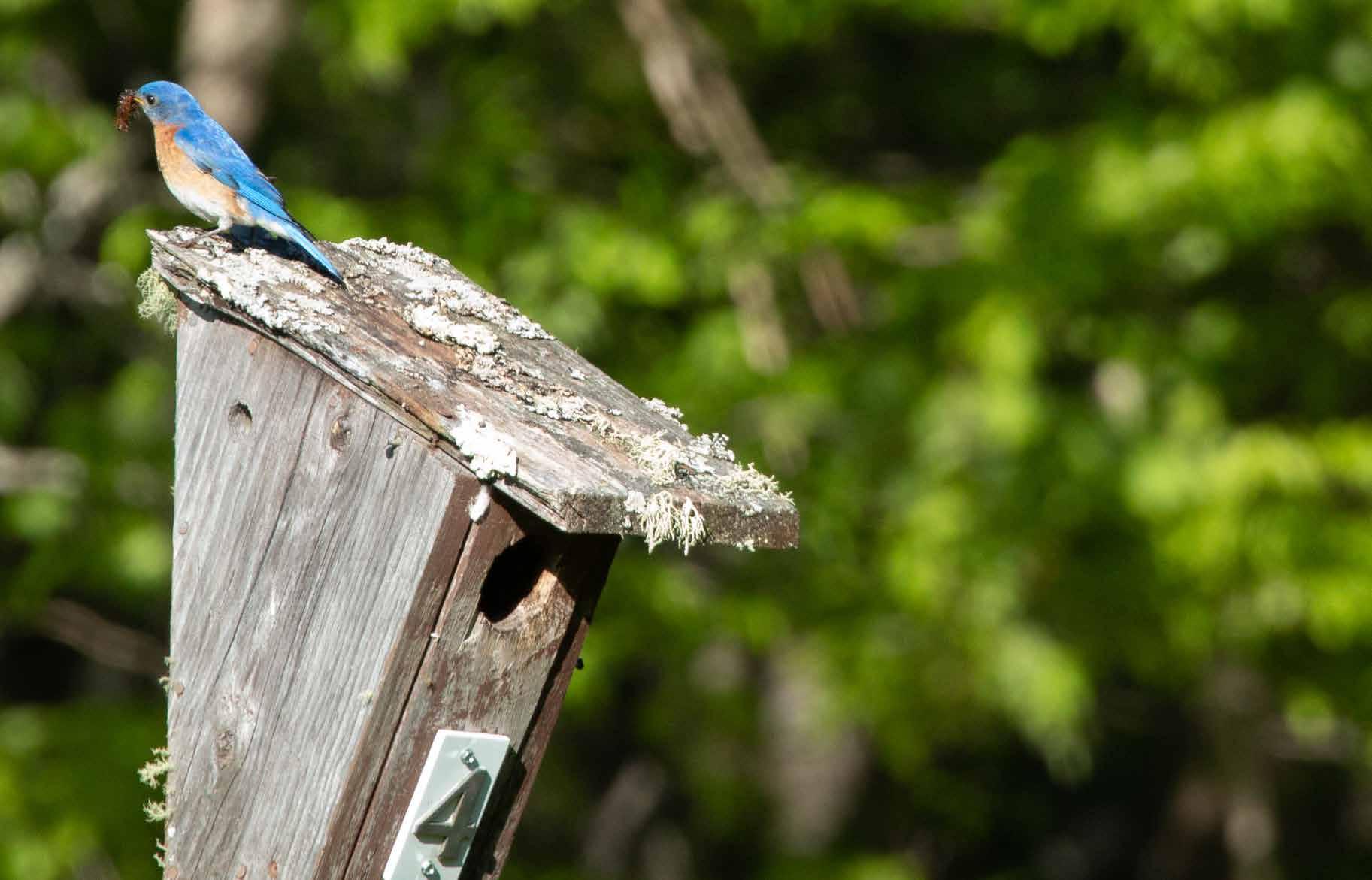
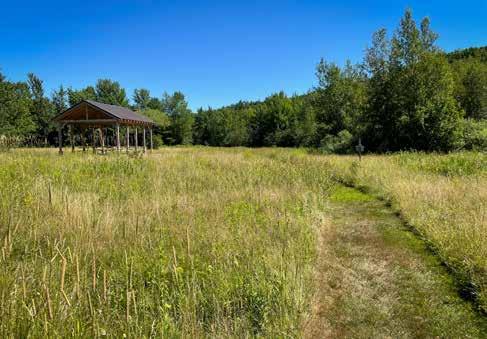
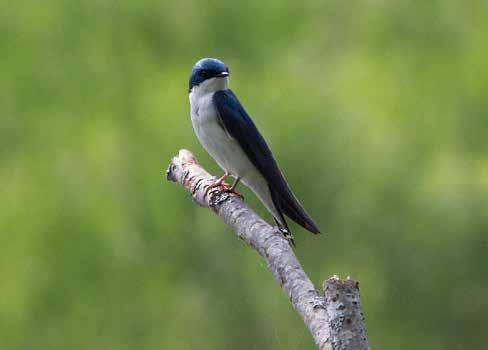
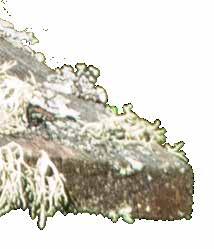
Each spring, I visit the bird nesting boxes that are posted throughout the meadows at Fields Pond Audubon Center in Holden. Standing at a distance, I wait for bluebirds to carry caterpillars to their hatchlings. Their azure feathers shine in the warm sunlight. I could spend hours watching them tend their nest.
For me, this is a rite of spring, something to look forward to. While most bird nests are tucked away in trees or shrubbery, bird nesting boxes — also called birdhouses — are out in the open, offering people the opportunity to view wild birds as they pair up and care for their young.
Yet I recently realized that while I enjoyed visiting nesting boxes, I actually knew little about them. And I’m not alone.


“It’s so misunderstood why we put them out,” said Doug Hitchcox, staff naturalist at the Maine Audubon.
Here’s the long story short: Many bird species nest in tree cavities, Hitchcox explained. These cavities are often formed from holes drilled by woodpeckers in dead or dying trees, which become scarce in well-developed areas.
“One thing humans are really good at removing from the landscape are dead trees,” Hitchcox said. “They worry about them falling on their houses or cars.”
Fewer rotting trees means fewer tree cavities for birds to nest in. Nesting boxes serve as an alternative.
In Maine, the bird species that most often use nesting boxes include eastern bluebirds, tree swallows, house wrens, black-capped chickadees, titmice, and nuthatches. In addition, certain ducks such as the wood ducks, common golden-eyes, and hooded mergansers will use larger nesting boxes that are placed near water. Owls and woodpeckers will also take up residence in birdhouses on occasion, if they are the correct size.
Hitchcox said that putting out a nesting box on your property is a great way to observe some of your resident birds while providing them suitable places to nest.
“Right up there with putting out bird feeders, I think it’s a great thing that people can do locally that will at least increase their appreciation of the birds,” he said, adding that a birdhouse might even be more beneficial to the birds than a feeder because birds often have plenty of natural food on the landscape.
Simple in design, nesting boxes are just what their name implies — wooden boxes that birds can enter through a hole to build their nest inside. These types of birdhouses often have a wall that can open for easy cleaning, plus drainage in the floor.
“Just drilling a few holes in the bottom corners allows moisture to get out,” Hitchcox said. “That often seems to be an oversight, and unfortunately, rain can get in sometimes.”
The roof is usually slanted to allow water to roll off of it, and the boxes are often placed on posts to hold them above the ground and out of the reach of predators.
The entrance hole of a bird nesting box is sized to fit a specific species. So, if placing one on a property, you can select a box for a species that you’ve already seen in the area. Or you select a box for a species you hope to attract to that area. Or you could simply erect a bluebird nesting box, Hitchcox said. That seems to be suitable for many cavity-nesting species.
Shops and online retailers sell premade nesting boxes, or you can build your own. It’s an entry-level craft, with detailed instructions available online. The Cornell Lab of Ornithology website, birds.cornell.edu, is a great place to learn more about constructing your own and finding a good place to put it.
Nesting boxes can come with a bit of drama. House wrens, for example, often will claim multiple boxes and won’t allow other birds to move in.
“They build all these dummy nests,” Hitchcox said. “The male will just shove sticks in every cavity he can find.”
House wrens are native to Maine. But nesting boxes can also attract a non-native, invasive species, such as the house sparrow, which Hitchcox said is fairly aggressive. He suggests people cover up
their nesting box entrances if that species tries to move in.
Hitchcox also advises that people keep house cats away from nesting boxes and feeders. Otherwise, your nesting birds may not survive.
Natural predators such as racoons and squirrels will sometimes raid nests, he warned. Predator guards are devices that can help prevent this from happening to your nesting box, but it’s a personal choice whether or not you want to invest in that.
“When you put out a nesting box, you’re inviting nature to happen in your backyard,” Hitchcox said. “And nature isn’t always kind.”
If looking for bird nesting boxes to visit in Maine, you don’t have to travel far. Many parks and preserves erect nesting boxes to attract different species and make them easier to view.
Maine Audubon, for example, has placed dozens of nesting boxes at its nature centers at Field Pond in Holden and Gilsland Farm in Falmouth. Trail networks at both preserves allow you to walk close to the boxes for easy observation.
The fields at Hirundo Wildlife Refuge in Alton are peppered with nesting boxes as well. In fact, the name “Hirundo” is Latin for swallow — a nod to the birds who use the boxes.
Bird nesting boxes are often placed in fields and along the edges of marshes. So if you know of a preserve or park with these habitats, keep your eyes peeled. For example, nesting boxes can be found in the fields of Curtis Farm Preserve in Harpswell and Law Farm in Dover-Foxcroft.
Nesting boxes can also be found along the Downeast Audubon Bluebird Trail, which was started in 2008 by Lynn Havsall. The most recent numbers, posted in 2022, show the trail at 443 birdhouses in 129 locations throughout Hancock County.
Sites of the trail include Blue Hill Mountain in Blue Hill, Great Pond Mountain Wildlands in Orland, Cooper Farm in Sedgwick, Jordan Homestead Preserve in Ellsworth, Furth Field in Surry, and many more. For more information, visit downeastaudubon.org.






















Maine’s moose hunt was resurrected in 1980, and since then, it has gone through a variety of changes. This year, the biggest change is that lottery applications began in April instead of January, but what isn’t changing is a family-friendly experience on lottery day: Saturday, June 15.
This year, the moose lottery and associated activities take place in Fort Kent. While event specifics were still being determined as of early spring, those attending can look forward to food trucks, educational and fun presentations on-stage and off, entertainment for all ages (moose calling contests, for sure), and vendors for the shopping inclined.
Fort Kent’s moose lottery festival takes place the same weekend as the annual Ploye Festival, which is Friday, June 14, at Lonesome Pine Lodge, so there will be plenty of food and fun for those making a weekend of it. The moose lottery events take place June 15 from 10 a.m. to 6 p.m. Go to www.fortkent.org for a schedule of events.
“[People] can bring lawn chairs if they want to sit outside of the pavilion,” says Suzi Paradis, Fort Kent’s town manager, “but we’ve contracted to have 750 chairs brought in.” There’s also a restroom facility at the park, and there will be additional portable bathrooms on-site. While there’s no ATM at the park, banks with ATM access are nearby, and many vendors have the capability to take digital payments, she says.
While ployes are pretty irresistible, the big draw of the weekend, of course, is the actual lottery, which will take place at the Riverside Park Pavilion from 2 to 5 p.m.
To have a chance in the lottery draw, you have to apply before 11:59 p.m. (ET) on May 15. Maine’s Department of Inland Fisheries and Wildlife, which manages
the moose permits and the lottery, no longer accepts paper applications; applications are only online (if you do not have a computer and/ or internet at home, MDIFW recommends going to your local library or asking a friend or relative for assistance).
Go to maine.gov/ifw/hunting-trapping/ hunting to apply, and to learn all about how to apply, who can apply, how to swap permits, district selection, and bonus points. One lottery chance is $15 or one bonus point. Maine residents who have their name drawn on June 15, must pay $52 for the permit; non-residents pay $585.
The chances of getting a coveted moose hunting permit vary year to year. The number of permits issued each year is based on the department’s moose management goals. For 2024, a total of 4,105 permits will be available. For more details, visit the MDIFW’s website.

Last year, about 8% of Maine residents (about one for every 12 applicants) were selected in the lottery, with 3,712 permits issued. MDIFW received 46,242 applications from residents and 26,204 from non-residents. Non-resident permits issued totaled 394, or about one permit for every 67 applicants. In total, MDIFW received 72,446 applications and issued 4,106, an increase of 26 permits over 2022.
The best immediate option to increase your chances of getting a permit this year is to choose a district when you apply that has a higher moose population. Higher moose populations result in a higher number of permits. A chart detailing permit allocations by district will be

available on MDIFW’s website in early spring.
If you’re playing the long game, you can increase your chances by accumulating bonus points. For Maine residents, bonus points are gained for each year they apply but do not get a permit. Non-residents can purchase additional chances.
The list of lottery winners will be posted on MDIFW’s website by 6 p.m. the day of the drawing.

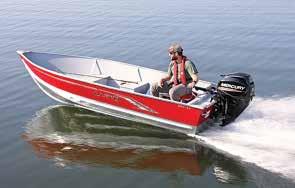
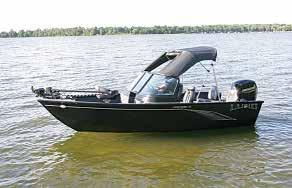












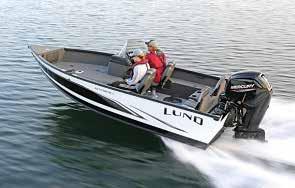



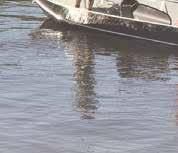







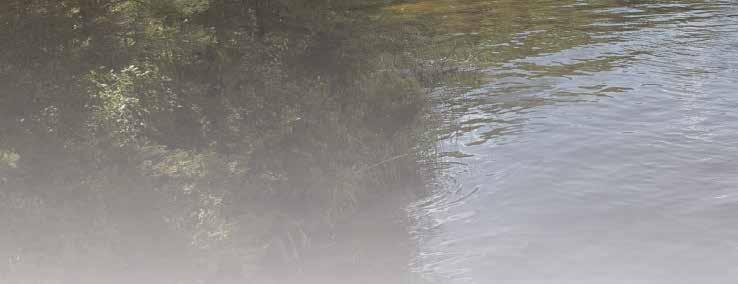



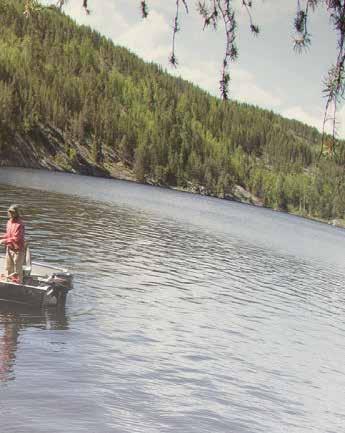








A magnificent stretch of wilderness in Aroostook County, Maine, is a 92 mile ribbon of lakes, rivers, ponds, and streams extending from the state's northern border to the town of Allagash. The remarkable area is widely renowned for its exquisite natural beauty and is also a popular destination for outdoor fans eager to cast a line in pursuit of salmon and trout.
This Maine paddle is one of America’s best adventures. From its roots in the history of Maine's Wabanaki tribes to its role in the state's booming lumber industry, the Allagash is steeped in heritage and natural wonder. As you explore the waterway, you will come across many historical sites and artifacts that speak to the area's cultural significance, such as the Ghost Trains on Eagle Lake or The Thoreau Campsite, which prolific American author Henry
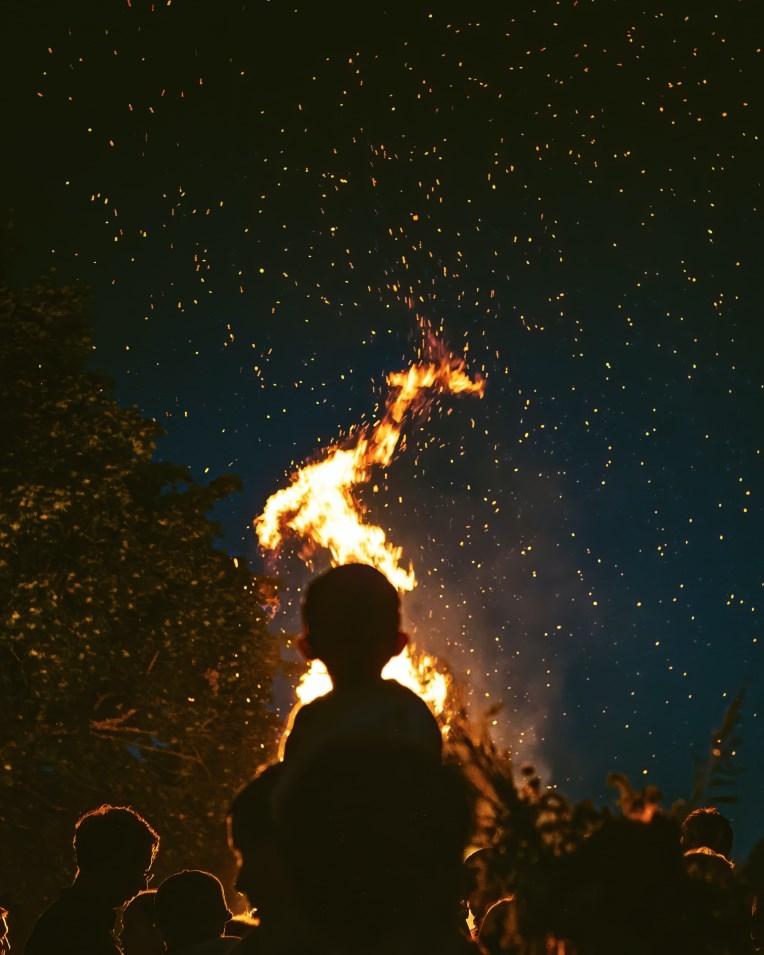
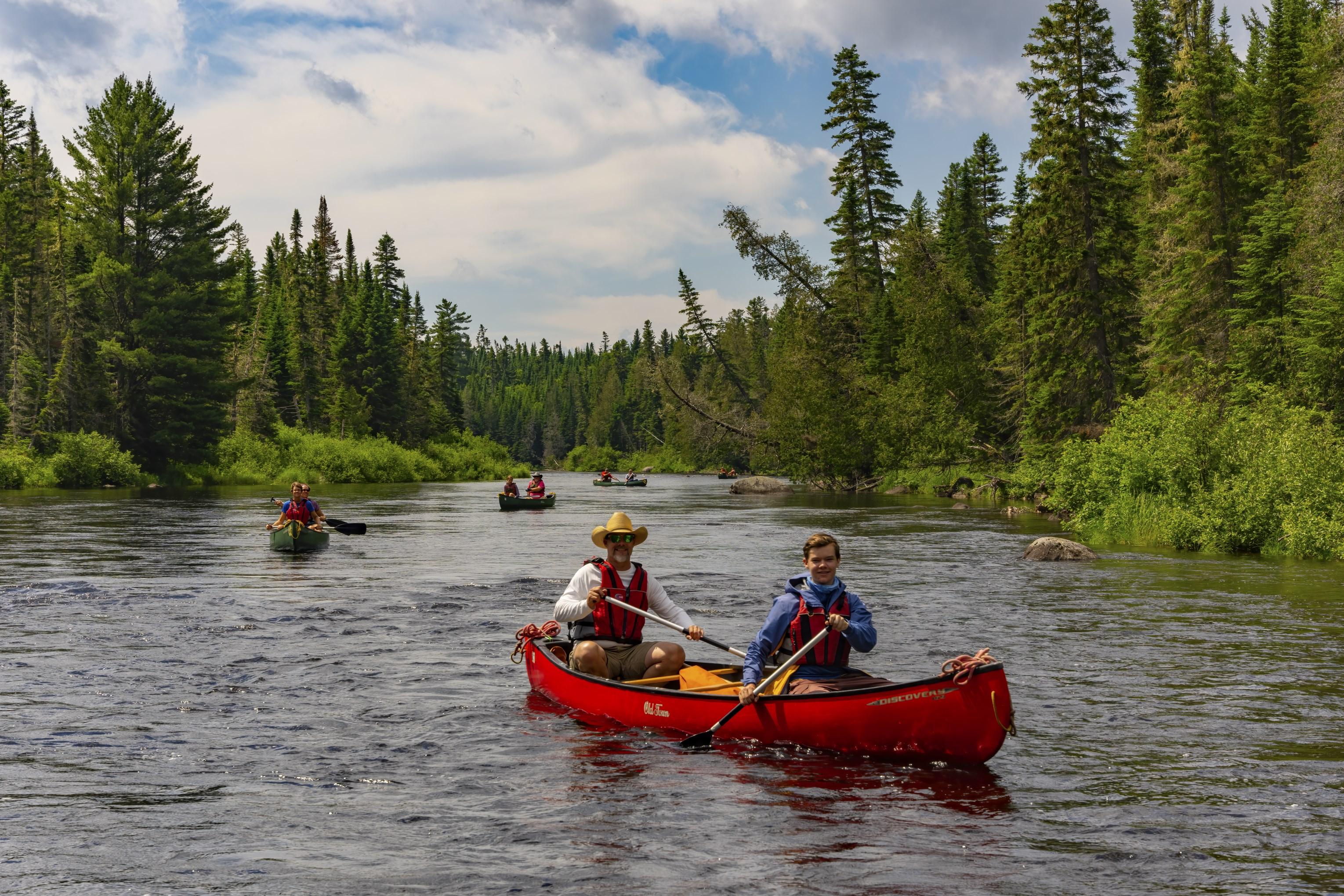


Explorers of the area partake in recreational activities such as c canoeing, fishing, and sightseeing - there are both tranquil stretches and whitewater rapids throughout the waterway. The full experience of the Allagash Wilderness Waterway will take you seven days to complete; you will camp in backcountry campsites and be miles from cell service. The night sky above the river ranks as one of New England's darkest skies. During the day, the popular activity other than paddling is fishing; a thriving population of n native Maine brook trout, l lake trout, and landlocked salmon can be found, and many of them have great size to them. The waterway is the backdrop to any tall tails for the local R Registered Maine Guides, and their legendary stories are still being made in the pristine
wilderness today.
On July 19, 1970, Maine's Allagash Wilderness Waterway became the first state -administered river to be designated by the United States as a component of the federal W Wild and Scenic River Program. This means the river is forever in its natural state and undeveloped making it a wild and remote destination ripe for an Aroostook adventure.
The best time to explore the Allagash is May to September, when the waterway comes alive with incredible wildlife sightings. M Moose encounters are frequent. The beast is most active half an hour after dusk and before dawn, but b bald eagles and b black bears are also possible sights.


TOP RIGHT Ledges Campsite on Umsaskis Lake
A ABOVE RIGHT
Trout fishing at Rocky Brook Falls off Hewes Brook Road
OPPOSITE
The darkest night sky holds many stories. Canoe & Camping
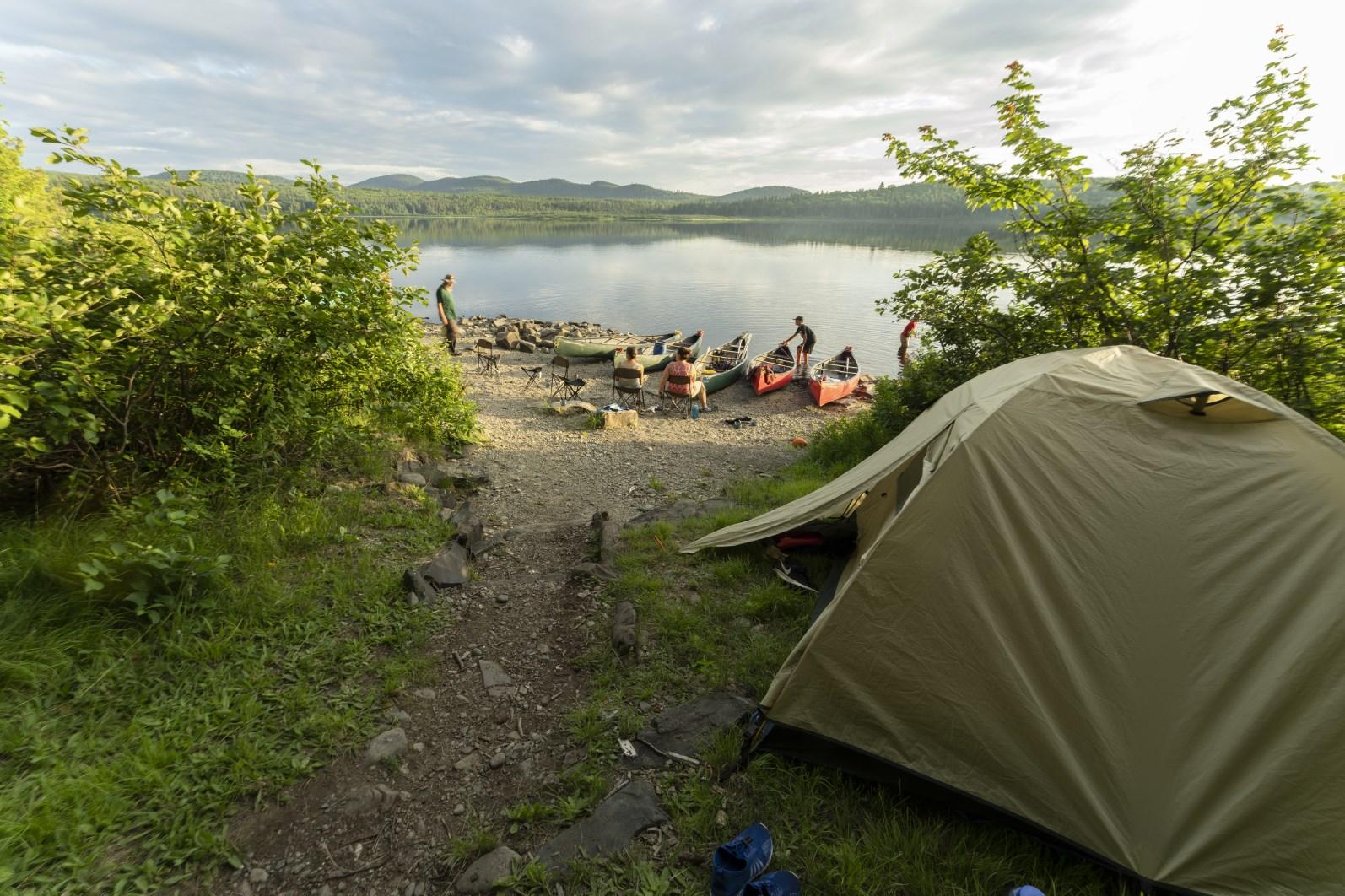
"I went to the woods because I wished to live deliberately, and see if I could not learn what it had to teach, and not, when I came to die, discover that I had not lived."
- Henry David Thoreau
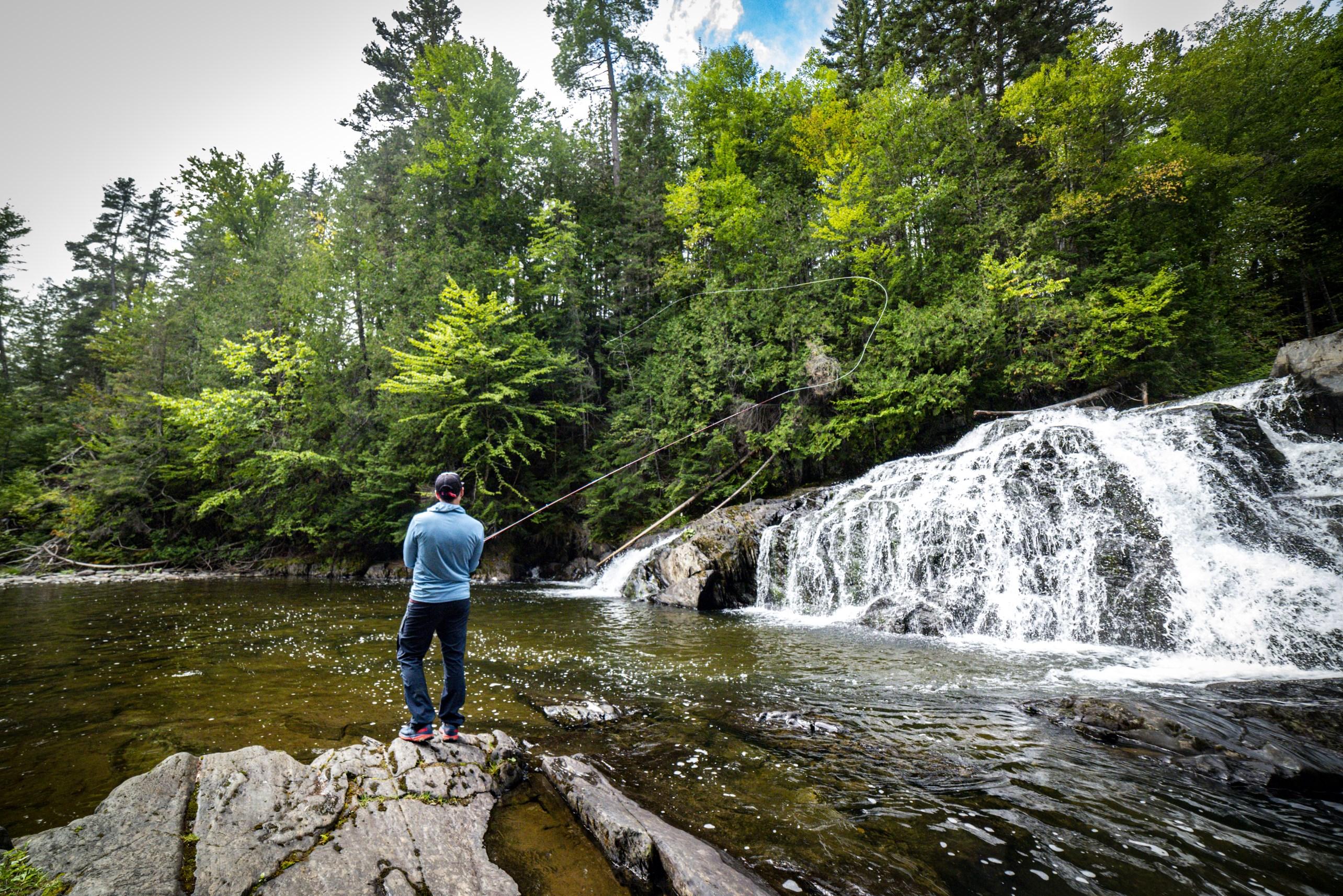
If you want a cabin experience on your Allagash visit, check out the sporting camps on E Eagle and Chamberlain Lake and take day trips to launch sites on the river. The camps offer activities like guided canoe excursions and allow anglers, paddlers, and hunters alike to experience the Allagash like never before. Campsites are where most overnight paddlers will stay - camping areas are on a first -come, first-served basis and restricted to 12 or fewer people. Sites designated along the water are plentiful but offer no amenities and are carry-in and carry-out, providing an authentic backcountry camping experience.
Due to its challenging and remote character, the Allagash is best enjoyed by enlisting the help of a
MAP IT: There are seven points where one can directly access the Waterway by motor vehicle. Search ‘Allagash Wilderness Waterway’ on w www MaineTrailFinder com
registered Maine Guide. For the outdoor adventurer seeking an authentic Maine wilderness experience, there no better way to experience the hidden gems of the region than with a Maine Guide.
With their experience, you can encounter the magic of the Allagash Wilderness Waterway in a safe and comfortable way. Whether you are a seasoned paddler or a beginner, they offer trips that cater to your needs and skill level. A Registered Maine Guides' expertise and guidance will ensure that you have a memorable and rewarding experience.
Whether you are an experienced canoeist or a rookie angler, you will surely savor this wild, remote corner of Maine.

Plan in advance to ensure the availability of campsites, guides, and safe water levels.

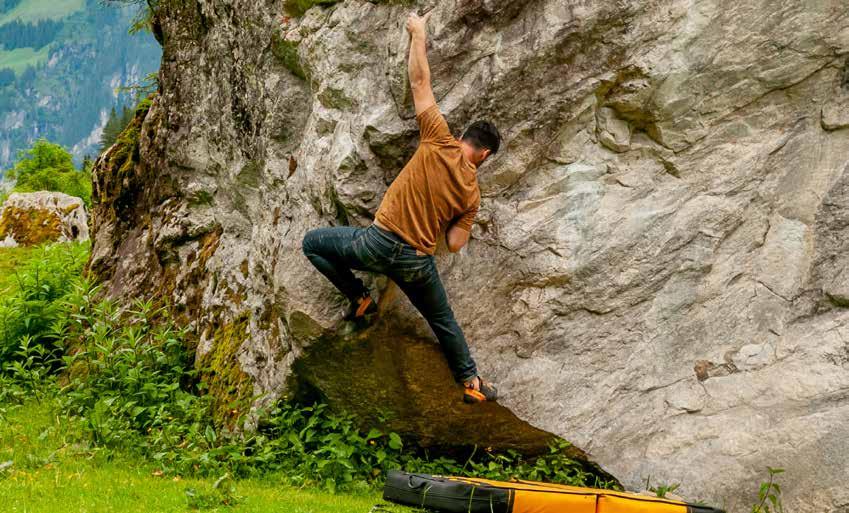

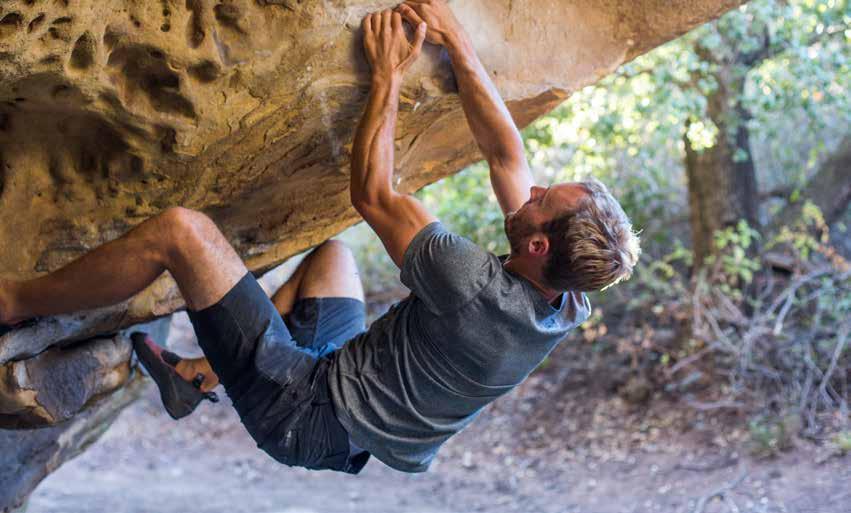
aine’s mountains, granite outcroppings, and rock-laden coastline beckon to climbing enthusiasts, offering up great venues for a specific type of climbing called bouldering.
Bouldering is rock climbing at its bare minimum. There are no ropes or harnesses involved. Instead, there’s typically just the climber, some specially designed shoes, a bag of chalk for grip, and a crash mat for falls.
The small amount of gear needed for bouldering makes the hobby more affordable and accessible than mountaineering or more traditional rock climbing with rope, which require lots of special equipment. The sport is growing in popularity, with its recent addition to the summer Olympics and expansion planned for upcoming Olympic games.
And the rocky coast of Maine provides some wonderful bouldering challenges.
“In our area, the premier spots are Canada Cliffs near Echo Lake and Great Head (both in Acadia National Park), which in my opinion is some of the best bouldering anywhere,” said Ryan Scott of the Atlantic Climbing School in Bar Harbor. “It consists of overhung cave-like features with extremely exciting and burly movements. It’s right next to the ocean, so you can hear waves lapping the rocky shore while you try to send your projects.”
The climbing is very technical and involves testing your skills in balancing and strength to make your way through a route in the cliff face without gaining much altitude in the process. It’s a free climb based on navigating without necessarily a Point A and Point B. This is especially true for bouldering outside versus bouldering at an indoor facility, where specific routes are marked with colored rocks.
An immense amount of upper body strength is needed for this type of climbing, and flexibility is a huge plus when trying to position your body in tight places to search for the next step in the climb. As a result, bouldering is a great workout for your arms, back, shoulders, and core.
When bouldering outside, it’s a good idea to bring mats with you in case of a fall. In bouldering, you typically only climb up to 12 or 15 feet, and there’s a technique to falling safely. For example, when falling you shouldn’t try to catch yourself; it’s best to relax your body before impact. You must accept the fall, which can sound counterintuitive to the layman. But falling is part of the sport and can be part of the fun.
It’s best to go into bouldering with a light-hearted, positive attitude, and be ready to embrace the ups and downs.
“Lots of crash pads and enthusiastic partners will help you fall where you should,” Scott said. “That’s what bouldering is all about — building strength and hanging out with your friends. Rope climbing is usually done in twos or threes, but with bouldering, since you don’t leave the ground, the more the merrier.”
And Acadia National Park is a great location for bouldering.
“Our pink granite is perfect. We have many different walls, sea caves, ocean cliffs, and 200foot multi-pitch routes,” Scott said. “Shagg Crag (on Bald Mountain in Woodstock) is another awesome spot in Maine. It features overhung hard sport climbing which is unusual for Maine.”
The options for climbing in our state are vast but there are certain spots that are held in particularly high regard.
“Katahdin and Great Head in Acadia are the most special spots to me,” Scott said. “They have a special energy that can’t really be described — it has to be experienced.”

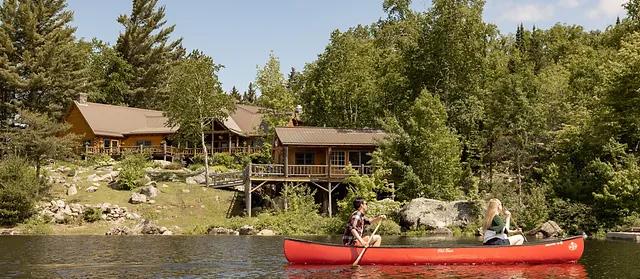

ATTEAN LAKE LODGE is a vacation experience set amidst the untouched beauty of Maine's wilderness. Its exclusive location on a 24-acre island enhances the allure of a remote getaway, perfect for families or individuals aiming to disconnect from the hustle and bustle of everyday life and immerse themselves in nature's beauty.
Despite its secluded setting, the lodge smartly balances the charm of rustic living with the conveniences of modern amenities. The presence of solar power and Wi-Fi in the main lodge, allows guests to maintain essential connections or fulfill work obligations without detracting from the immersive natural experience.
Accommodations at the lodge include 14 charming log cabins, each offering picturesque lake views that promise a serene start and end to every day. The use of gas lights and kerosene lanterns preserves the authentic rustic ambiance, while the inclusion of full baths with hot running water ensures comfort and convenience.
The range of activities available caters to a broad spectrum of interests and energy levels. Guests can opt for a day of leisurely relaxation within the lodge, bask by the serene lake, or engage in thrilling adventures such as tubing and water skiing. The vast wilderness surrounding the lodge invites exploration, whether it’s hiking the trails or discovering the lake and rivers by boat.
One of the lodge’s most appealing features is its all-inclusive offering, which encompasses all meals, daily housekeeping, various activities, and entertainment. This comprehensive package allows guests to fully immerse in their vacation without the concerns of planning and additional expenses, making Attean Lake Lodge a genuinely stress-free retreat.
The tradition of welcoming guests and providing an unforgettable escape into nature has been carried on for generations at Attean Lake Lodge. It represents not just a place to stay, but an experience rich with opportunities to forge lasting memories, reconnect with loved ones, and enjoy the peaceful embrace of the wilderness.
When the snow melts and the weather warms up, is there anything better than heading out to one of Maine’s lakes or rivers or spending a day by the ocean? From extreme water sports to a lazy day on the river, Maine has something for everyone and you won’t leave disappointed. Here are some of the best ways to get out on the water this time of year.
Head out for a few hours with nothing but fresh Maine air and your kayak or canoe. With so many places to put in that offer tranquility and beautiful views, it’s hard to choose just one place to visit.
DUCK LAKE PUBLIC LANDS: With over 27,000 acres of forested land, Duck Lake has lots of water to paddle on as well as primitive camping. Located in northern Hancock County, 70 miles northeast of Bangor, Duck Lake, the
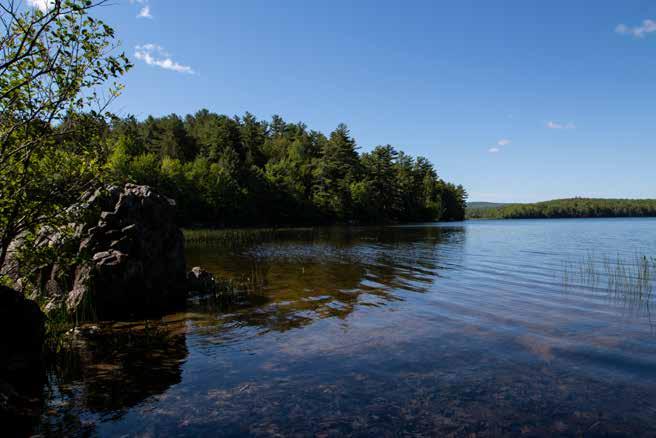
Unknown Lakes, and Gassabias Lake offer lots to do and explore, including swimming, wildlife watching, canoeing, camping, motorized boating, fishing, and ATV riding.
FIELDS POND AUDUBON CENTER: Located seven miles southeast of Bangor in Holden, Fields Pond Audubon Center features a 191-acre pond, plus a large sanctuary with trails that take you in and out of wetland, trails, fields, forest, and lakefront. There are many programs offered year-round as well as day camps for children. The pond has a public boat launch area, ideal for launching canoes and kayaks. The sanctuary is free and open to everyone year round.
PUSHAW LAKE: Close to Bangor, Pushaw Lake is a popular place to boat, kayak, and canoe. It’s a long and narrow lake that’s fairly developed with homes and camps with some quiet spots along the north end near Hudson. There are some nice big islands you can pad -
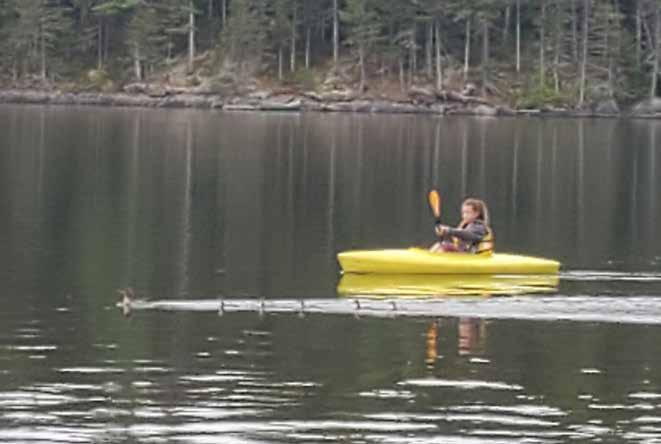
dle to as well as lots of wildlife to see. There are no fees for boating on the lake, but there are fees for the commercial campground.
Whether you’re an avid angler or a newcomer to the sport, there’s an endless number of spots around the state to cast a line. Just remember, everyone over the age of 16 needs a Maine fishing license — and be sure to check the current Maine Open Water & Ice Fishing Laws first.
SWAN LAKE: Waldo County’s Swan Lake can accommodate your every need. This body of water has a plethora of fish, including brook trout, bass, lake trout, smallmouth bass, and yellow perch. Swan Lake State Park also has a great area to swim, with a lifeguard, picnic sites, grills, shelters sites, and games.
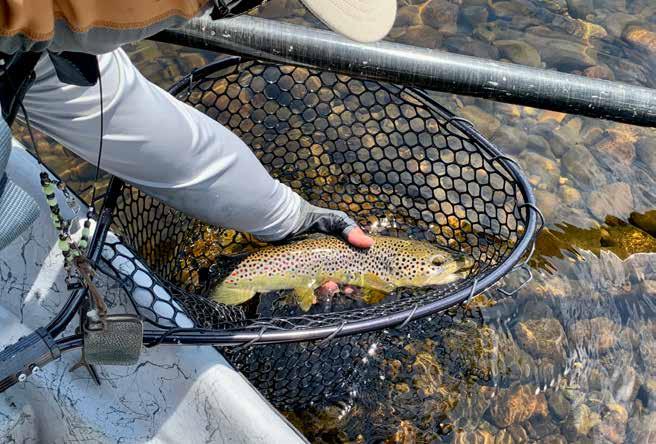
PENOBSCOT RIVER: With hundreds of miles of water, the Penobscot River now has lots of game fish species, including brook trout, landlocked salmon, smallmouth bass, white perch. The river is accessible in many areas of the state, but if you’re looking to fish and paddle in a quieter area, try the east branch of the Penobscot, northeast of Millinocket.
Whether you crave the excitement of riding the rapids or prefer a leisurely float, Maine has plenty of riverriding fun.
KENNEBEC RIVER: Kennebec River is 170 miles long, running south from Moosehead Lake. It offers some of the best whitewater rafting in Maine. Whether you’re a beginner or want a class IV adventure, there’s something for everyone.

In addition, Kennebec River Tube Rentals through Three Rivers Whitewater offers tube rentals for those looking for a more relaxing adventure on the water. (Tip: Reserve an extra tube to carry a cooler for drinks and snacks.) Beginning at The Forks, the tubing trip typically takes 2.5 to 3 hours to complete, and a shuttle will take you back to their base.
DEAD RIVER: At only 43 miles long, Dead River packs an adventurous punch. It has the longest track of whitewater on the east coast. You can schedule a river tour, but must be at least 12 years of age.
THE FORKS: Located 18 miles north of Bingham on Route 201, The Forks is where the Dead River and The Kennebec River intersect. Many people crave the adrenaline rush of this incredible rafting experience which is one of the most popular places to raft in Maine.

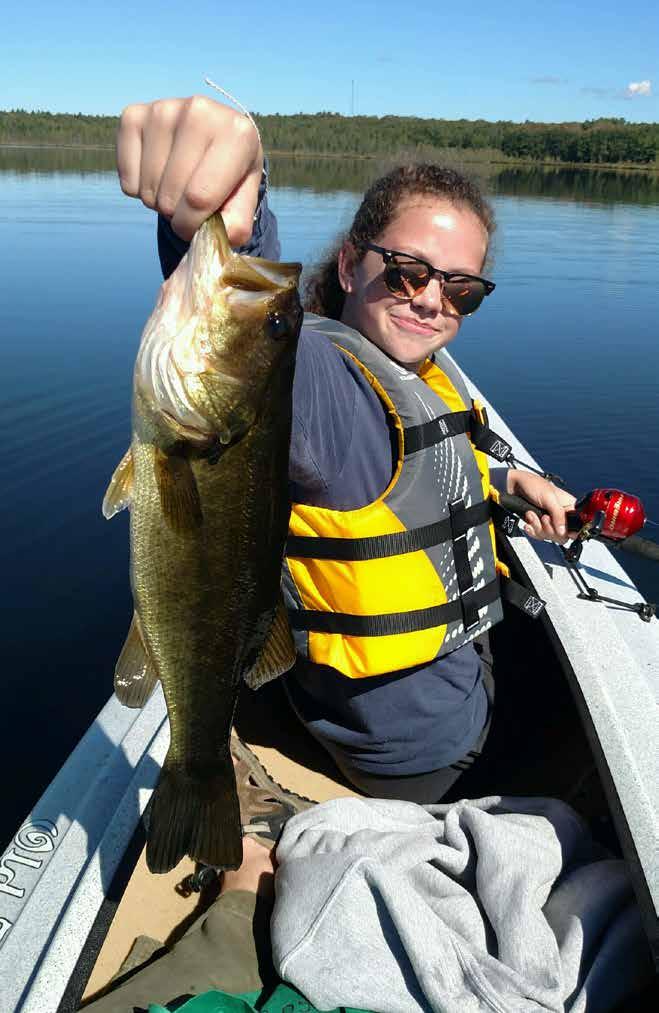
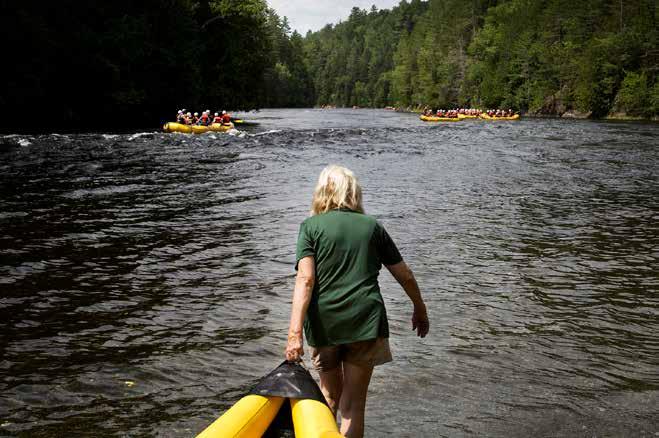
When I started making plans to rent a rustic cabin on a lake, I simply needed a getaway. It was March of my son’s senior year of high school and the start of his final outdoor track season, the second year of my two-year grad program, my daughter was in production for two dance shows, I worked full time, taught on the side, both kids had school obligations, a loved one was in the hospital with a long uncertain recovery and … I just needed a pause.
Visions of a serene lake where I could just stop thinking twirled in my head.
I won part of the stay at Wheeler’s Camps in an auction at the Bangor Symphony Orchestra Soiree. After talking to the owners, I paid to extend it to nearly a week, booking a green-trimmed cabin with sweeping porches, no internet, and a lake practically at the doorstep.

It was my vision brought to life.
Growing up in New York, this wasn’t the kind of vacation my family took. We’d usually fly somewhere for sun, skiing, or sightseeing. But after nine years in Maine and hearing countless stories of going upta camp, I wanted my kids and I to try it — to vacation in a place without clocks and to-do lists, floating on the water, paddling canoes, eating when we felt like it.
It was months before we’d leave. In the meantime, we kept going, constantly busy. But I could feel the burn out at the edges of my psyche. It was like the edges of a photo turning to char when heated with a lighter. The upcoming stay at the cabin was a beacon — a promise of relaxation to come.
As the time drew near, I collected linens and food, planned meals loosely, and bought drinks for a week. The cat sitter was lined up. I tried to be casual about it, but it was a lot of work. Preparing to relax and unwind was another item on my to-do list.
But finally, we drove down the highway, through populous areas to a tiny town just outside Waterville with a lake. The cabin looked just like the picture. Stepping out of the car, we could hear the rustle of leaves, the chirp and song of birds, and the gentle movement of the water. It was serene.
“We can just go right in,” I told my kids, who were 15 and 17. “Let’s look around before we bring everything in.”
Inside, dark wood and brick formed the living room, dining area, and kitchen. A small bathroom awaited just beyond the rustic stove used for decoration only. Another porch, screened in and overlooking the water, awaited with rocking chairs and a table. On the second floor, two bedrooms were divided by walls that didn’t reach the peaked ceiling.
Back downstairs, we unloaded coolers and bags, bedding and games. I’d brought two tote bags full of books for myself. My son had brought a fishing


Our rustic waterfront cottage in Maine’s Belgrade Lakes region, perfect for a quiet getaway and mental reset
rod with all the accoutrements. My daughter had a massive puzzle. The owners dropped by to say hello and let me know how to reach them if we needed anything.
Then we were alone. We blew up rafts. My son got his fishing rod ready. My daughter contemplated swimming.
While the cabin had electricity and water, it was ultimately a week without the pressures and distractions of the internet, streaming services, to-do lists, and more. And what we found was a certain peacefulness — rising when our bodies wanted to, talking or not, laughing but also enjoying the silence together. We were living in the moment, unfettered by the lists and responsibilities of our life back home.
We spent hours floating on the lake on our rafts. We swam. My son caught a sunfish.
With each passing moment, I felt the stress melt away. My mind quieted. We all slept more deeply in the quiet upstairs rooms without the interruption of alarms or the blue of screens.
As we floated on the lake on our last day, soaking up every moment of the vacation we could, we talked about the stay. There were parts we loved — the game playing, the water fun, the quiet ease of the week. But the rusticness of the cabins was a one-time thing for us. And that’s okay — we got what we needed from our week away.

PUntreated out-of-state firewood is banned in Maine, and even in-state firewood can spread pests to new areas.

eople who care for forests have long had a laser focus on firewood as a major threat to forest health and productivity. Years ago, it became clear that the movement of firewood significantly accelerates the spread of the destructive e emerald ash borer. Remarkably, about threequarters of the early infestations in Michigan were directly tied to this mode of transportation. The invasive A Asian longhorned beetle has similarly been traced back to the movement of infested firewood.
Many forest threats can be carried accidentally in a load of firewood. Just consider the following list: o oak wilt fungus, which has killed oaks in the Midwest for decades; the s spotted lanternfly, an expert hitchhiker that threatens not only trees, but also important crops like apples, grapes and hops; and of course, the b browntail moth, which affects both the health of trees and people.
The kicker is that while the list of what we know moves with firewood is long, new threats continue to come in from other reg ions and infiltrate forests near ports and other settled areas. H High impact species, like emerald ash borer and Asian longhorned beetle, h have been found at a rate of roughly o one every 2 and a half years, according to a December 2010 article in BioScience.

Shin Pond Village, a 100-acre, family owned and operated resort, is nestled in the heart of the Katahdin Region. Offering an array of lodging and recreational activities for adventure enthusiasts, this exclusive destination is fully equipped with a eet of state-ofthe-art Polaris ATVs and Side-by-Sides to explore the


Katahdin region! Elevate your off-road experience to a whole new level and settle in for a few days. With campsites located on the brook, electric RV sites, cottages, guest suites and waterfront homes, you and your group will have everything you need at this countryside escape. With access to hundreds of miles of trails, get ready to explore all over Mt. Chase, Maine. Located just fteen miles from the Northern entrance to Baxter State Park, Shin Pond Village offers four seasons of fun with great shing, uncrowded hiking and plenty of wildlife. Buckle up and get ready to discover the mountains, lakes and wildlife in northern Maine!








